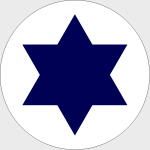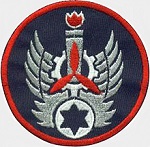Hobby Master HA4553 Israeli Defense Force Boeing F-15A Baz Multi-Role Fighter - "Foxbat Killer," Tel Nof, Israel, 1981 [Low-Vis Scheme] (1:72 Scale)
"Obsolete weapons do not deter."
- British Prime Minister Margaret Thatcher
 The McDonnell Douglas F-15 Eagle is an American twin-engine, all-weather tactical fighter aircraft designed by McDonnell Douglas (now part of Boeing). Following reviews of proposals, the United States Air Force selected McDonnell Douglas's design in 1967 to meet the service's need for a dedicated air superiority fighter. The Eagle first flew in July 1972, and entered service in 1976. It is among the most successful modern fighters, with over 100 victories and no losses in aerial combat, with the majority of the kills by the Israeli Air Force.
The McDonnell Douglas F-15 Eagle is an American twin-engine, all-weather tactical fighter aircraft designed by McDonnell Douglas (now part of Boeing). Following reviews of proposals, the United States Air Force selected McDonnell Douglas's design in 1967 to meet the service's need for a dedicated air superiority fighter. The Eagle first flew in July 1972, and entered service in 1976. It is among the most successful modern fighters, with over 100 victories and no losses in aerial combat, with the majority of the kills by the Israeli Air Force.
The Eagle has been exported to Israel, Japan, and Saudi Arabia. The F-15 was originally envisioned as a pure air-superiority aircraft. Its design included a secondary ground-attack capability that was largely unused. The aircraft design proved flexible enough that an all-weather strike derivative, the F-15E Strike Eagle, an improved and enhanced version which was later developed, entered service in 1989 and has been exported to several nations. As of 2017, the aircraft is being produced in different variants with production to end in 2022.
Pictured here is a stunning 1:72 scale diecast replica of an Israeli Defense Force Boeing F-15A Baz multi-role fighter known as "Foxbat Killer," then deployed to Tel Nof, Israel, during 1981.
Sold Out!
Dimensions:
Wingspan: 7-inches
Length: 10-1/2-inches
Release Date: December 2015
 Historical Account: "Foxbat Killer" - The F-15 went into action for the first time during March 1978, flying top cover for Israeli ground operations against Palestinian terrorists in Southern Lebanon. Only on July 27th 1979 did the Eagles score their first air-to-air victory. The IAF had sent the Eagles to protect aircraft flying attack sorties against PLO targets in Lebanon when 8 Syrian MiG-21s attempted to engage the attacking aircraft. Five MiG-21s were downed using missiles and cannons in the Eagle's first engagement worldwide. Four more MiGs were downed in September 1979, another MiG in late 1980 and another pair on December 31st, 1980. As formerly mentioned, one of the prime reason for the developement of the F-15 and its acquisition by the IAF had been the MiG-25 Foxbat, which had frustrated the IAF in the early 1970s. On February 13th, 1981, an opportunity was finally awarded to the F-15 to engage the Foxbat, and in the first worldwide kill of the type, an IAF F-15 shot down a Foxbat. Another MiG-25 was downed on July 29th and a third on August 31st, 1982, in a joint F-15 - Hawk SAM ambush. F-15As also flew top cover for F-16 Fighting Falcons during their famous attack of the Osirak Nuclear Plant in Baghdad, on June 7th, 1981, escorting the Falcons all the way to the Iraqi capital.
Historical Account: "Foxbat Killer" - The F-15 went into action for the first time during March 1978, flying top cover for Israeli ground operations against Palestinian terrorists in Southern Lebanon. Only on July 27th 1979 did the Eagles score their first air-to-air victory. The IAF had sent the Eagles to protect aircraft flying attack sorties against PLO targets in Lebanon when 8 Syrian MiG-21s attempted to engage the attacking aircraft. Five MiG-21s were downed using missiles and cannons in the Eagle's first engagement worldwide. Four more MiGs were downed in September 1979, another MiG in late 1980 and another pair on December 31st, 1980. As formerly mentioned, one of the prime reason for the developement of the F-15 and its acquisition by the IAF had been the MiG-25 Foxbat, which had frustrated the IAF in the early 1970s. On February 13th, 1981, an opportunity was finally awarded to the F-15 to engage the Foxbat, and in the first worldwide kill of the type, an IAF F-15 shot down a Foxbat. Another MiG-25 was downed on July 29th and a third on August 31st, 1982, in a joint F-15 - Hawk SAM ambush. F-15As also flew top cover for F-16 Fighting Falcons during their famous attack of the Osirak Nuclear Plant in Baghdad, on June 7th, 1981, escorting the Falcons all the way to the Iraqi capital.
On June 6th, 1982, Israel began operation "Peace For Gaillee" and its ground forces pushed into Lebanon in pursuit of Palestinian terrorists. Contact was expected to be made with the Syrians, the main power broker in Lebanon, but during the first days of the fighting the Syrians mainly kept their forces at bay, only a few dogfights taking place. Only as IDF forces continued their push northward into Lebanon, approaching areas under Syrian control, did contact become inevitable and the IAF got to exercise its full ability. On June 9th a single IAF pilot managed to shoot down four Syrian MiGs and land his aircraft after it was hit by an air-to-air missile. By the end of the first week of hostilities, over 85 Syrian aircraft had been shot down, 40 of them by IAF F-15 Eagles. Most kills were made with either the AIM-9 Sidewinder or the Israeli Python 3 short range missiles, a few (including the various MiG-25s) were shot down with the AIM-7 Sparrow, while a number of aircraft were cannon kills.
On October 1st, 1985, eight Israeli F-15s made their way across the Mediterranean to strike at the PLO headquarters in Tunis in retaliation of the murder of three Israeli citizens in Larnaka, Cyprus. In the IAF's longest range attack ever, the F-15s, refuelled in flight by Boeing 707s, flew 2040km to their targets, and destroyed the buildings located on the Tunisian beachfront. The Defence Minister at the time, Yitzhak Rabin (the same whose government had been toppled by the arrival of the first F-15s and who in 1994 authorized the purchase of the F-15I) had commented on the attack : "the long arm of Israeli retribution will reach them wherever they are". Following this raid, Syrian MiGs began challenging IAF reconnaissance missions in Lebanon, and on November 30th 1985, IAF F-15s shot down two MiG-23s, in the last air engagement between Israel and Syria to this day.






![USAF Boeing F-15C Eagle Multi-Role Fighter - 85-0114, 58th Tactical Fighter Squadron "Gorillas", 33rd Fighter Wing, Eglin AFB, Florida, 1991 [Low-Vis Scheme] (1:72 Scale)](http://cdn4.volusion.store/qh9e9-jdqv9/v/vspfiles/photos/HA4531-1.jpg?v-cache=1740197136)


